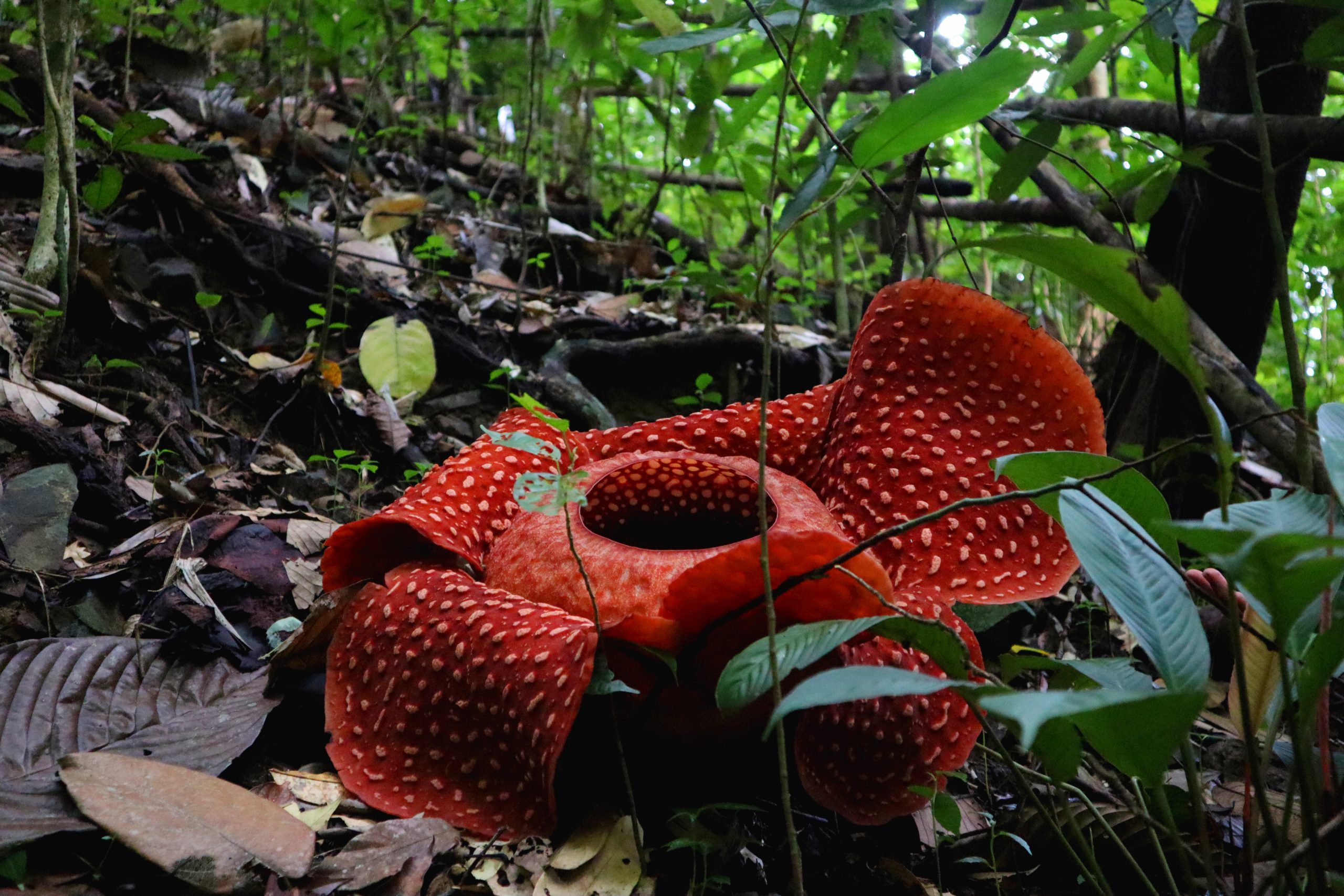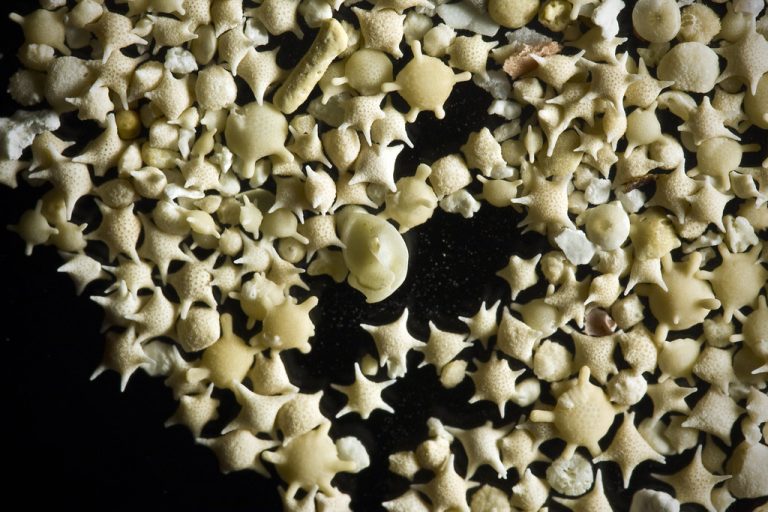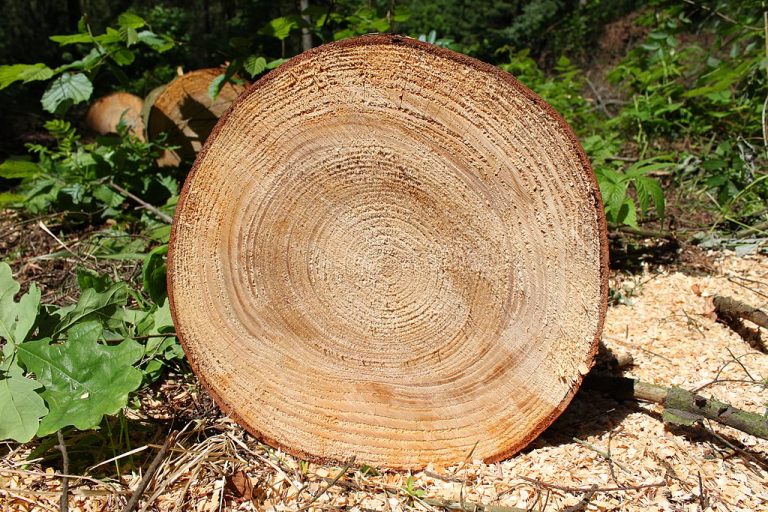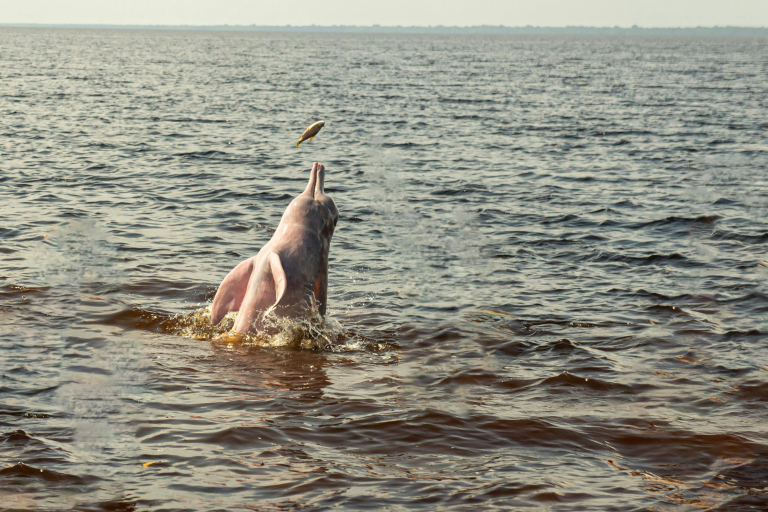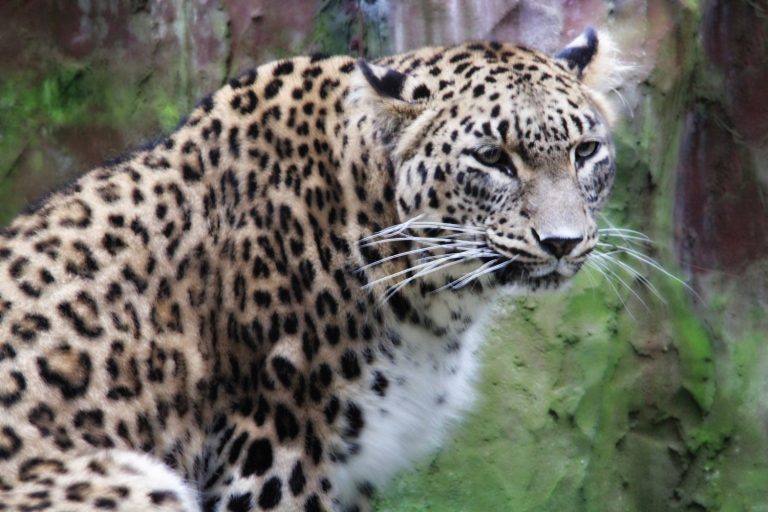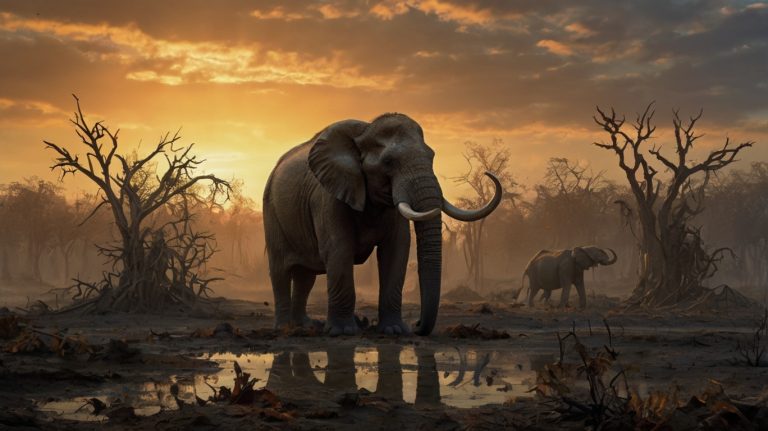The Enigmatic Rafflesia arnoldii: Nature’s Largest and Smelliest Flower
Imagine a plant that doesn’t have the usual structure of a plant, with leaves and stems, bears the world’s largest flower, which smells like rotting flesh, and is entirely parasitic.
Weird, isn’t it? But such a plant does exist, and it’s known scientifically as Rafflesia arnoldii.
In this post, I will accompany you to take a peek into the fascinating world of this unusual plant.
Habitat and Distribution
Rafflesia arnoldii thrives in the humid rainforests of Southeast Asia. It is mainly found in dense forest areas where its host plant, a vine known as Tetrastigma, is abundant.
Specific Habitats
Rafflesia arnoldii thrives in specific habitats, primarily in lowland tropical rainforests and montane forests, where high humidity and consistent rainfall are ideal for its survival.
Since it has these specific habitat requirements, habitat destruction, often driven by deforestation and land conversion for agricultural purposes, poses a threat to its existence.
The Flower of Rafflesia arnoldii: The Largest in the World
The flower of Rafflesia arnoldii is unusual like the plant itself.
Physical Characteristics and Order
Rafflesia arnoldii flower has a very foul odor. It smells like rotting flesh. This unusual scent is important for attracting specific pollinators that are essential for the plant’s reproduction.
In addition to its unique smell, the Rafflesia arnoldii flower has remarkable physical characteristics.
The flower can grow up to one meter (3.3 feet) in diameter and can weigh as much as 11 kilograms (24 lbs).
The petals of the flower are typically reddish-brown with white spots and have a texture like leather.
All these physical characteristics give this flower a very unique appearance.
Lifecycle and Growth
The life cycle of Rafflesia arnoldii is a fascinating and complex process that happens in several stages.

Bud Formation
The life cycle of Rafflesia arnoldii begins when a seed lands on a host plant and germinates.
The roots tap into the host plant’s vascular system, extract nutrients from it, and a small bud is formed.
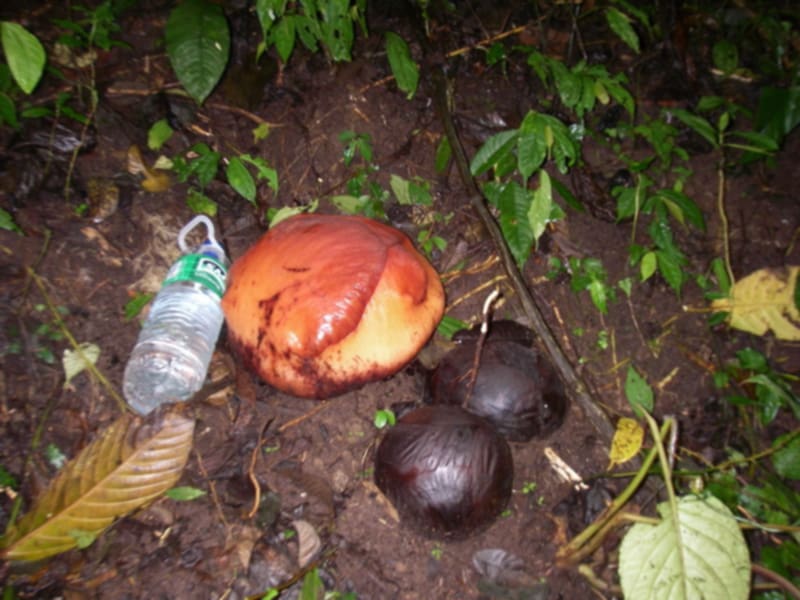
The development of the bud is influenced by environmental factors such as temperature and humidity.
Blooming
The bud undergoes a remarkable transformation over several days as it matures and expands into a huge flower.
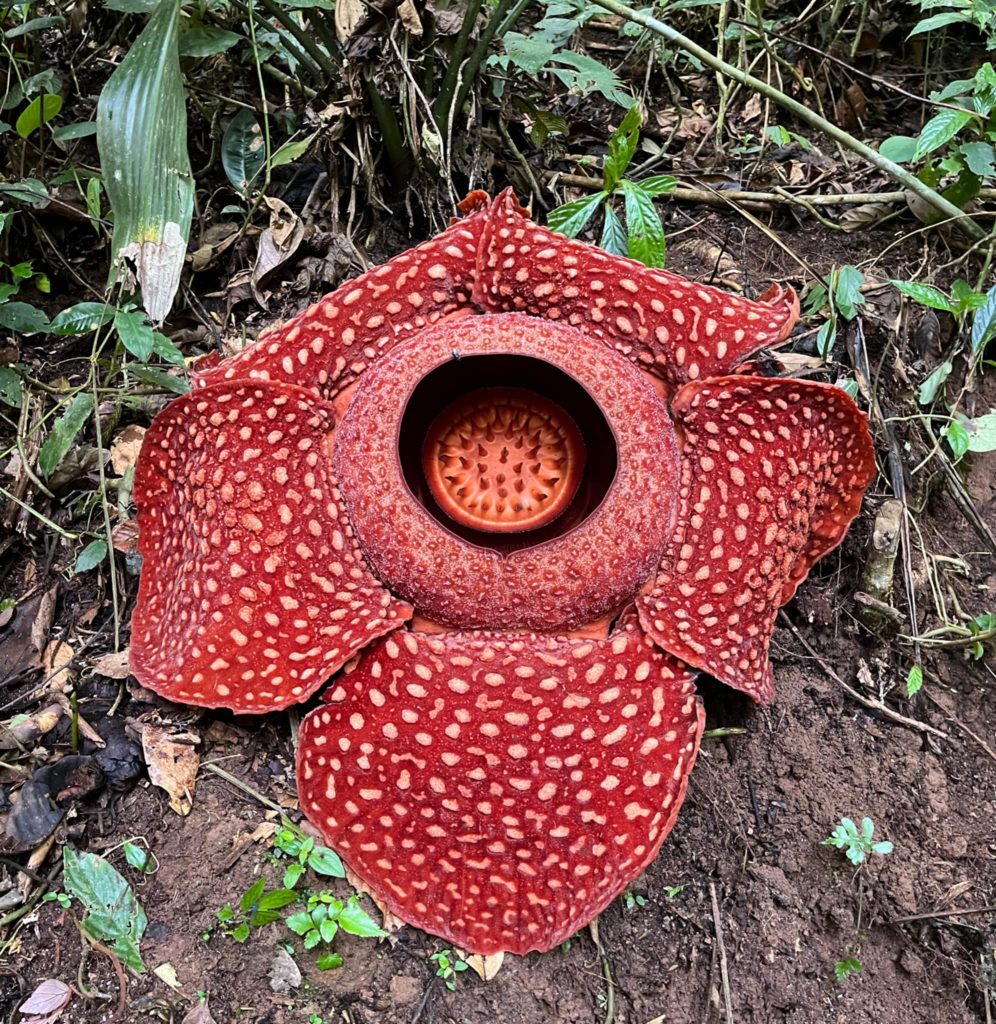
This visually striking blooming process is essential for the plant’s reproductive success.
Favorable environmental conditions such as increased moisture and warmth are vital for the rapid growth during this stage.
Duration of Bloom
Once fully bloomed, the flower of Rafflesia arnoldii lasts for about five to seven days under optimal conditions.
During this period, the flower emits its characteristic foul odor, attracting pollinators like carrion flies and beetles.
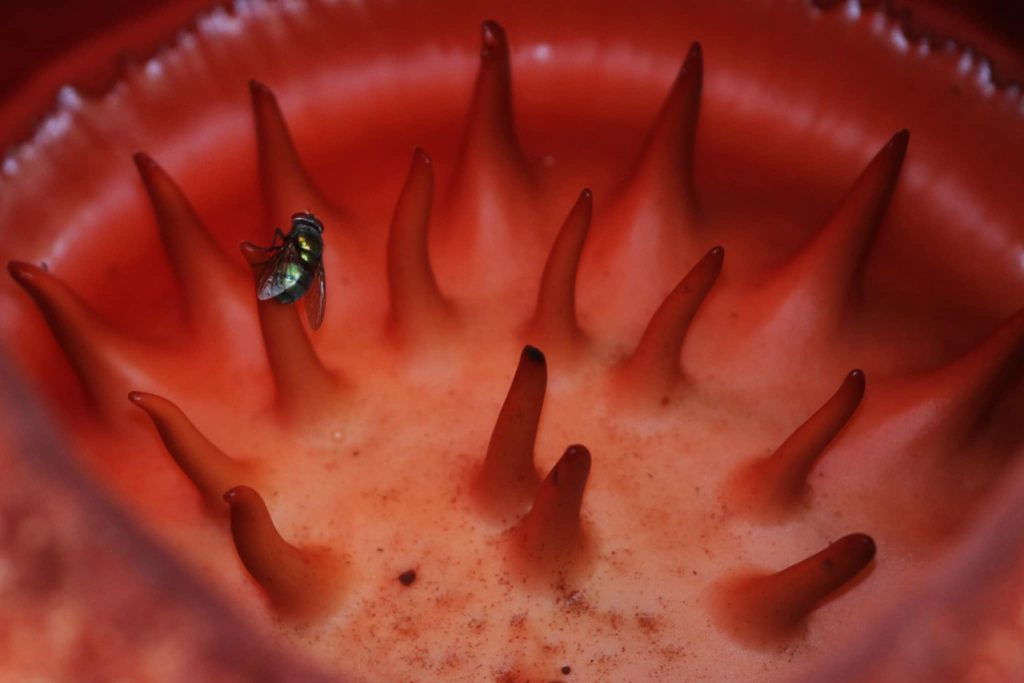
Environmental triggers like heavy rainfall influence the timing of blooming as they help initiate the flowering process.
Reproductive Process
The reproductive strategy Rafflesia arnoldii uses is fascinating.
Attracting Pollinators
The flower emits a strong odor, like that of rotting meat.
This smell attracts the plant’s primary pollinators, carrion flies and beetles. These insects are attracted to the scent as they have evolved to seek out decaying carcasses.
Pollination Process
Rafflesia arnoldii is dioecious, meaning it bears distinct male and female flowers.
The pollination process involves both male and female flowers.
Pollination occurs when a pollinator, typically carrion flies, visits a male flower first. These flies carry the pollen with them to female flowers, fertilizing them.
This special relationship between Rafflesia arnoldii and its pollinators demonstrates how it has evolved to rely on specific insects for reproduction.
Fruit Formation and Seed Dispersal
A fruit, in the form of a berry, is developed from the successfully fertilized female flower.
This berry has many sticky seeds, which are crucial for the plant’s reproduction.
As the fruit matures, it changes so its interior with a white endocarp and brown seeds gets exposed.
Fruit-eating animals such as rodents then eat the fruit and spread the seeds over the habitat.
The seeds that land on host plants then germinate, sending roots into the host plants to extract nutrients and form buds.
Uses & Cultural Significance
So, how does this plant relate to the people of its geographical region?
Let’s see:
Cultural Significance
Rafflesia arnoldii is a culturally important plant in Southeast Asia. It symbolizes the rich biodiversity of the region and is often celebrated in local traditions.
The flower has also appeared in various forms of art and media, including postage stamps in Indonesia.
Uses in Traditional Medicine
Local communities use Rafflesia buds in traditional medicine. They are believed capable of aiding pregnancy and to work as aphrodisiacs.
However, enough scientific research has not been conducted to support these claims.
Other Interesting Facts About Rafflesia arnoldii
Let’s look at some other fascinating aspects of this unusual plant.
Unique Adaptations
Rafflesia arnoldii shows several unique adaptations that give it a better chance of survival in its specific habitat.
One of the most remarkable adaptations is its ability to generate heat during flowering, making its foul smell even stronger.
This helps attract specific pollinators, such as carrion flies and beetles, that are drawn to the smell of decaying flesh.
Horizontal Gene Transfer
Another fascinating aspect of Rafflesia arnoldii is its ability to engage in horizontal gene transfer, a phenomenon that allows it to acquire genetic material from its host plant.
By incorporating genes from its host, Rafflesia can be better adapted and efficient as a parasite and, therefore, has a better chance of survival in a competitive environment.
Comparison with Other Large Flowers
Rafflesia arnoldii is often compared to other large flowering plants, particularly the Titan arum (Amorphophallus titanum), but it is a different plant.
Even though both plants bear flowers of impressive size and strong odors, they belong to different families and have unique characteristics that set them apart.
Rafflesia arnoldii is entirely parasitic and relies solely on its host plant for nutrients, but Titan arum has the conventional plant structure with leaves and stems and can photosynthesize.
Their pollination strategies are different too. Rafflesia mainly attracts carrion flies with its smell, while Titan arum attracts a greater variety of pollinators.
Conservation Status
Even though Rafflesia arnoldii has not been assessed for the IUCN red list, it faces many threats:
Habitat Loss
Habitat loss, mainly due to deforestation and land conversion for agriculture, is a significant threat.
With the increasing demand for timber and agricultural land, huge areas of tropical rainforests where Rafflesia thrives are being cleared.
This not only removes the Rafflesia’s host plant, Tetrastigma but also disrupts the ecosystems that support its growth.
Also, the fragmentation of habitats can isolate these plants, making it difficult for them to reproduce.
Urbanization and infrastructure development contribute to this problem too, affecting the natural environments where this unique plant thrives.
Without immediate conservation efforts to protect its habitat, Rafflesia arnoldii’s future is uncertain, with declining populations and increasing vulnerability to extinction.
Ecotourism Impact
Even though ecotourism has the potential to raise awareness and funds for protecting this plant, it poses a threat to the plant’s survival, too.
As more tourists gather to see this unique flower, the increased foot traffic can disrupt its delicate habitat.
This is not helped by the fact that local communities may rather have more tourists for the money they bring in than work on conserving the plant.
There are some cases where landowners deliberately harm Rafflesia plants on neighboring properties, competing to attract tourists.
Additionally, ecotourism sites often don’t take measures to exhibit these plants without disturbing their natural environment.
Conclusion
Rafflesia arnoldii is a plant that doesn’t have the usual plant anatomy, like leaves and stems.
It’s found in the rainforests of Southeast Asia.
It has a life cycle that consists of a few distinct stages.
Its flower is the world’s largest and smells like decaying flesh.
This order attracts carrion flies and beetles, who act as the plant’s pollinators.
Rafflesia arnoldii is entirely parasitic. Its host plant is the Tetrastigma wine, from which it extracts nutrients and acquires genes.
It holds cultural significance for the people in its geographic range and is used in traditional medicine of the region.
Its survival is threatened by habitat loss and irresponsible ecotourism practices, and its future is uncertain.

